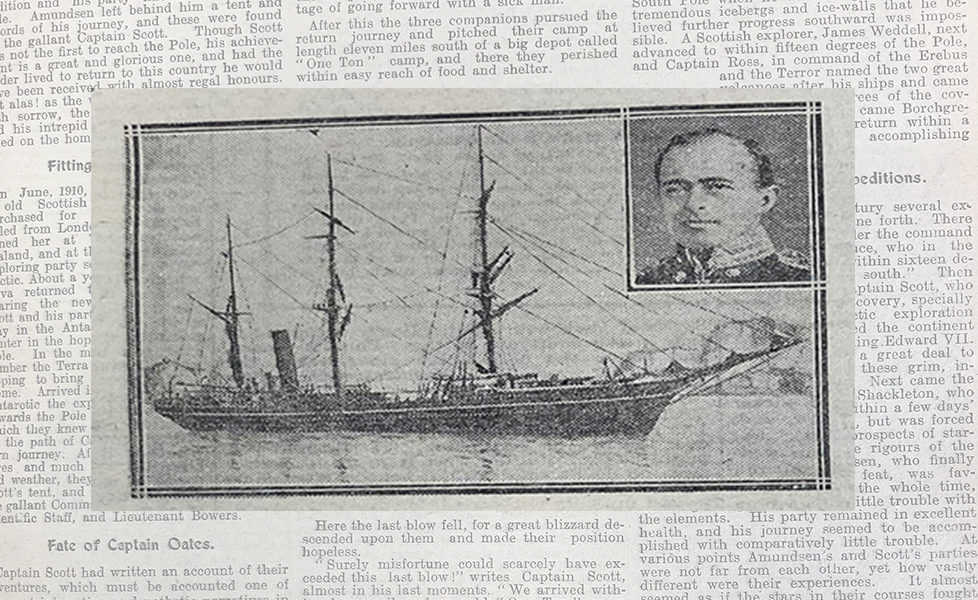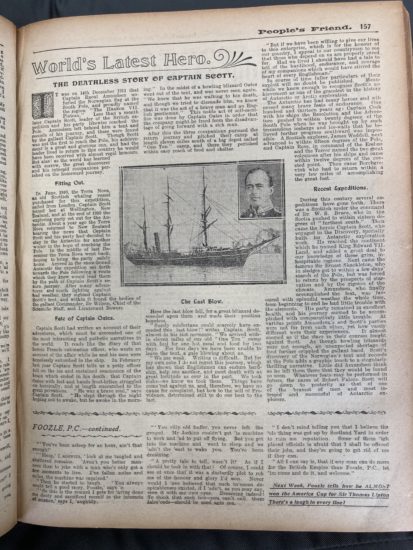
I was raking around at the DC Thomson Archives recently, looking for some material for a secret project, when I discovered this piece.
It’s about the polar explorer Robert Falcon Scott, and his ill-fated attempt to reach the South Pole.
I’ve always loved the tales from “the Great Age of Exploration”. And having grown up in Dundee, this one is particularly familiar.
Scott’s ship, the RRS Discovery, was built here at the beginning of the last century. And it’s moored here still, as a fantastic visitor attraction.
What’s fascinating about this piece is that it was published in the “Friend” just one year after Scott’s tragic death.
It’s really interesting to see what a contemporary source had to say about the expedition. Even if they do get Roald Amunden’s name wrong!
See what you think.
World’s Latest Hero
The Deathless Story Of Captain Scott
It was on 14th December 1911 that Captain Raoul Amundsen unfurled the Norwegian flag at the South Pole.
Less than a month later Captain Scott, leader of the British expedition and his party likewise reached the Pole. Amundsen left behind him a tent and records of his journey, and these were found by the gallant Captain Scott.
Though Scott was not the first to reach the Pole, his achievement is a great and glorious one. Had the leader lived to return to this country he would have been received with almost regal honours.
But alas! as the world has learned with sorrow, the great discoverer and his intrepid companions perished on the homeward journey.
Fitting out
In June 1910, the Terra Nova, an old Scottish whaling vessel purchased for this expedition, sailed from London. Captain Scott joined her at Wellington, New Zealand. At the end of 1910 the exploring party set out for the Antarctic.
About a year ago the Terra Nova returned to New Zealand bearing the news that Captain Scott and his party had decided to stay in the Antarctic for another winter in the hope of reaching the Pole.
In the middle of last December the Terra Nova went back, hoping to bring the party safely home. Arrived in the snow-bound Antarctic the expedition set forth towards the Pole following a route which they knew would lead them by the path of Captain Scott’s return journey.
After many adventures and much fighting against bad weather, they sighted Captain Scott’s tent. And within it found the bodies of the gallant Commander, Dr Wilson, Chief of the Scientific Staff, and Lieutenant Bowers.
Fate of Captain Oates
Captain Scott had written an account of their adventures, which must be accounted one of the most interesting and pathetic narratives in the world.
It reads like the diary of that heroic French submarine officer, who wrote an account of the affair while he and his men were hopelessly entombed in the ship.
In February last year Captain Scott tells us a petty officer fell on the ice and sustained concussion of the brain which ended in his death; that Captain Oates with feet and hands frost-bitten struggled on heroically, and at length succumbed to the great privations.
“He was a brave soul,” says Captain Scott. “He slept through the night hoping not to awake, but he awoke in the morning.”
In the midst of a howling blizzard Oates went out of the tent and was never seen again.
“We knew that he was walking to his death, and though we tried to dissuade him, we knew that it was the act of a brave man and an English gentleman.”
This noble act of self-sacrifice was done by Captain Oates in order that the company might be freed from the disadvantage of going forward with a sick man.
After this the three companions pursued the return journey and pitched their camp at length eleven miles south of a big depot called “One Ton” camp. And there they perished within easy reach of food and shelter.

The full feature. Image courtesy of DC Thomson Ltd.
The Last Blow
Here the last blow fell, for a great blizzard descended upon them and made their position hopeless.
“Surely misfortune could scarcely have exceeded this last blow!” writes Captain Scott, almost in his last moments.
“We arrived within eleven miles of our old ‘One Ton’ camp with fuel for one hot meal and food for two days. For four days we have been unable to leave the tent, a gale blowing about us.
“We are weak. Writing is difficult. But for my own sake I do not regret this journey, which has shown that Englishmen can endure hardship, help one another, and meet death with as great fortitude as ever in the past.
“We took risks — we know we took them. Things have come out against us, and, therefore, we have no cause for complaint, but bow to the will of Providence, determined still to do out best to the last.
“But if we have been willing to give our lives to this enterprise, which is for the honour of our country, I appeal to our countrymen to see that those who depend on us are properly cared for.
“Had we lived I should have had a tale to tell of the hardihood, endurance, and courage of my companions which would have stirred the heart of every Englishman.”
Many heroes
In course of time fuller particulars of their exploit will no doubt be published. Meanwhile we know enough to recognise Scott’s achievement as one of the grandest in the history of exploration.
The Antarctic has had many heroes and witnessed many brave feats of endurance. One hundred and thirteen years ago Captain Cook with his ships the Resolution and the Adventure pushed to within twenty degrees of the South Pole. He was brought up by such tremendous icebergs and ice-walls that he believed further progress southward was impossible.
A Scottish explorer, James Weddell, next advanced to within fifteen degrees of the Pole. And Captain Ross, in command of the Erebus and the Terror, came within twelve degrees of the coveted point.
Then came Borchgrevink who had to return within a very few miles of accomplishing the great feat.
Recent Expeditions
During this century several expeditions have gone forth.
There was a Scottish under the command of Dr WS Bruce, who pushed to within sixteen degrees of “furthest south”.
Then came the heroic Captain Scott, who voyaged in the Discovery, specially built for Antarctic exploration work. He reached the continent which he named King Edward VII Land, and added a great deal to our knowledge of these grim, inhospitable regions.
Next came the famous Sir Ernest Shackleton, who in sledges got to within a few days’ march of the Pole, but was forced to return by the prospects of starvation and by the rigours of the climate.
Amundsen, who finally accomplished the feat, was favoured with splendid weather the whole time. From beginning to end he had little trouble with the elements.
His party remained in excellent health, and his journey seemed to be accomplished with comparatively little trouble. At various points Amundsen’s and Scott’s parties were not far from each other, yet how vastly different were their experiences.
It almost seemed as if the stars in their courses fought against Scott. As though howling blizzards were not enough, an unexpected shortage of food further crippled the gallant band.
Scott’s discovery of the Norwegian’s tent and records at the Pole adds a graphic touch to a singularly thrilling narrative. Little did Amundsen think as he left them that they would be found so soon.
Whatever feats may be performed in future, the name of Robert Falcon Scott will go down to posterity as that of one of the bravest of men and most intrepid and successful of Antarctic explorers.
Click here to read our Tracey’s review of “The Worst Journey In the World”, a first-hand account of Captain Scott’s doomed journey.




